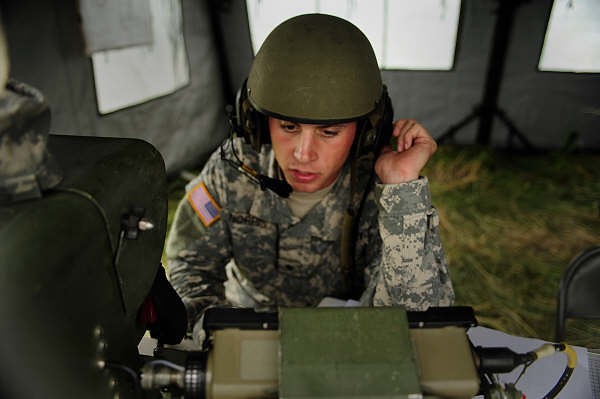

Topic Objective
Develop and demonstrate a Comms capability and Multi-Function resource manager for the AN/TPQ-53 radar system. The AN/TPQ-53 radar system detects, classifies, tracks, and determines the location of enemy indirect fire in either 360- or 90-degree modes.
Description
With the emergence of digital array technologies capable of supporting Multi-Function capabilities, the Army is interested in developing and integrating a Comms capability into the AN/TPQ-53 radar system, as well as a Multi-Function resource manager to efficiently manage the Comms and Radar functionality.
The main purpose of this effort is to investigate, develop, and demonstrate concepts/algorithms to enable timely data sharing between multiple radar systems for improved Target Location Accuracies and Probability of Detection.
Effective deployment of these advanced concepts/algorithms may serve to enhance the performance of current and future Army CTA radar systems, such as the AN/TPQ-53 for improved TLE and Pd, as well as enabling future ‘cooperative’ radar concepts. This Program of Record is funded annually for modernization efforts, commonly referred to as Modernization Development Efforts (MDE), which provide a conduit for the integration of improved hardware and emerging software algorithms. This includes initial design and development efforts, laboratory design, productization into the software baseline, and field-testing.
Phase I
Identify and develop an initial comms capability for the TPQ-53 DDREX radar and investigate candidate Machine Learning (ML) based techniques to manage Radar/Comms functionality with minimal impact to Radar performance. Specific considerations: Investigate comms mode implementation (including encryption); benefit of comms to the Counter-fire Target Acquisition (CTA) mission; conduct studies on size, power consumption, speed, and complexity of candidate comms modes and radar/comms management algorithms; and perform modeling & simulation on viability of candidate modes and algorithms. At end of phase I, prepare and present a study report to: (1) identify comms mode and radar/comms management algorithms, (2) present use cases for combined radar/comms capability for CTA mission, (3) identify size, power consumption, speed, and complexity of selected modes/algorithms, and (4) demonstration plan for Phase II.
Phase II
Develop and demonstrate a prototype comms mode and radar/comms management algorithms utilizing surrogate radar systems.
Phase III
Productization of improvements into the software baseline: provide analysis, design updates, implementation support, and systems engineering testing for proposed algorithmic updates developed under Phase I and demonstrated in Phase II. Additionally, update the software and firmware to accommodate the final design and provide the following: software source code and executable files, system/subsystem specification updates, and performance specification document updates. Lastly, prepare lab tests, engineering test plans, and procedures to demonstrate the performance of the algorithms during a test event.
Submission Information
To submit full proposal packages, and for more information, visit the DSIP Portal.

References:
E. William, J. Vesecky, and K. Pister. Agile Multi-Function Arrays. Defense Technical Information Center, 2007. Stutzman, Warren L., and Thiele, Gary A. Antenna Theory and Design 3rd edition. John Wiley & Sons, 2012. Skolnik, Merrill. Radar Handbook 3rd Edition. McGraw Hill, 2008
Topic Objective
Develop and demonstrate a Comms capability and Multi-Function resource manager for the AN/TPQ-53 radar system. The AN/TPQ-53 radar system detects, classifies, tracks, and determines the location of enemy indirect fire in either 360- or 90-degree modes.
Description
With the emergence of digital array technologies capable of supporting Multi-Function capabilities, the Army is interested in developing and integrating a Comms capability into the AN/TPQ-53 radar system, as well as a Multi-Function resource manager to efficiently manage the Comms and Radar functionality.
The main purpose of this effort is to investigate, develop, and demonstrate concepts/algorithms to enable timely data sharing between multiple radar systems for improved Target Location Accuracies and Probability of Detection.
Effective deployment of these advanced concepts/algorithms may serve to enhance the performance of current and future Army CTA radar systems, such as the AN/TPQ-53 for improved TLE and Pd, as well as enabling future ‘cooperative’ radar concepts. This Program of Record is funded annually for modernization efforts, commonly referred to as Modernization Development Efforts (MDE), which provide a conduit for the integration of improved hardware and emerging software algorithms. This includes initial design and development efforts, laboratory design, productization into the software baseline, and field-testing.
Phase I
Identify and develop an initial comms capability for the TPQ-53 DDREX radar and investigate candidate Machine Learning (ML) based techniques to manage Radar/Comms functionality with minimal impact to Radar performance. Specific considerations: Investigate comms mode implementation (including encryption); benefit of comms to the Counter-fire Target Acquisition (CTA) mission; conduct studies on size, power consumption, speed, and complexity of candidate comms modes and radar/comms management algorithms; and perform modeling & simulation on viability of candidate modes and algorithms. At end of phase I, prepare and present a study report to: (1) identify comms mode and radar/comms management algorithms, (2) present use cases for combined radar/comms capability for CTA mission, (3) identify size, power consumption, speed, and complexity of selected modes/algorithms, and (4) demonstration plan for Phase II.
Phase II
Develop and demonstrate a prototype comms mode and radar/comms management algorithms utilizing surrogate radar systems.
Phase III
Productization of improvements into the software baseline: provide analysis, design updates, implementation support, and systems engineering testing for proposed algorithmic updates developed under Phase I and demonstrated in Phase II. Additionally, update the software and firmware to accommodate the final design and provide the following: software source code and executable files, system/subsystem specification updates, and performance specification document updates. Lastly, prepare lab tests, engineering test plans, and procedures to demonstrate the performance of the algorithms during a test event.
Submission Information
To submit full proposal packages, and for more information, visit the DSIP Portal.
References:
E. William, J. Vesecky, and K. Pister. Agile Multi-Function Arrays. Defense Technical Information Center, 2007. Stutzman, Warren L., and Thiele, Gary A. Antenna Theory and Design 3rd edition. John Wiley & Sons, 2012. Skolnik, Merrill. Radar Handbook 3rd Edition. McGraw Hill, 2008
